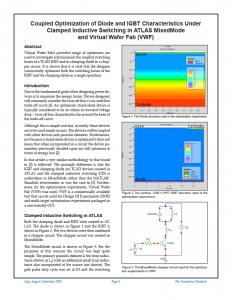Coupled Optimization of Diode and IGBT Characteristics Under Clamped Inductive Switching in ATLAS MixedMode and Virtual Wafer Fab (VWF)
Abstract
Virtual Wafer Fab’s powerful range of optimizers are used to investigate and minimise the coupled switching losses of a TCAD IGBT and its clamping diode in a chopper circuit. It is shown that it is vital that the designer concurrently optimizes both the switching losses of the IGBT and the clamping diode in a single operation.
Introduction
One of the fundamental goals when designing power devices is to minimise the energy losses. Device designers will commonly consider the turn-off loss v’s on-state loss trade-off curve [1]. An optimized, stand-alone device is typically considered to be on where its forward voltage drop / turn-off loss characteristics lie around the knee of the trade-off curve.
Although this is simple and fast, in reality these devices are to be used inside circuits. The devices will be coupled with other devices and parasitic elements. Furthermore, just because a stand-alone device is optimized it does not mean that when incorporated in a circuit the device parameters previously decided upon are still optimum in terms of energy loss [2].
In this article a very similar methodology to that found in [2] is followed. The principle difference is that the IGBT and clamping diode are TCAD devices created in ATLAS and the clamped inductive switching (CIS) is undertaken in MixedMode rather than the MATLAB/Simulink environment as was the case in [2]. Furthermore, for the optimization experiments, Virtual Wafer Fab (VWF) was used. VWF is a commercially available tool that can be used for Design Of Experiments (DOE) and multi-target optimization experiments packaged in a user friendly GUI.



